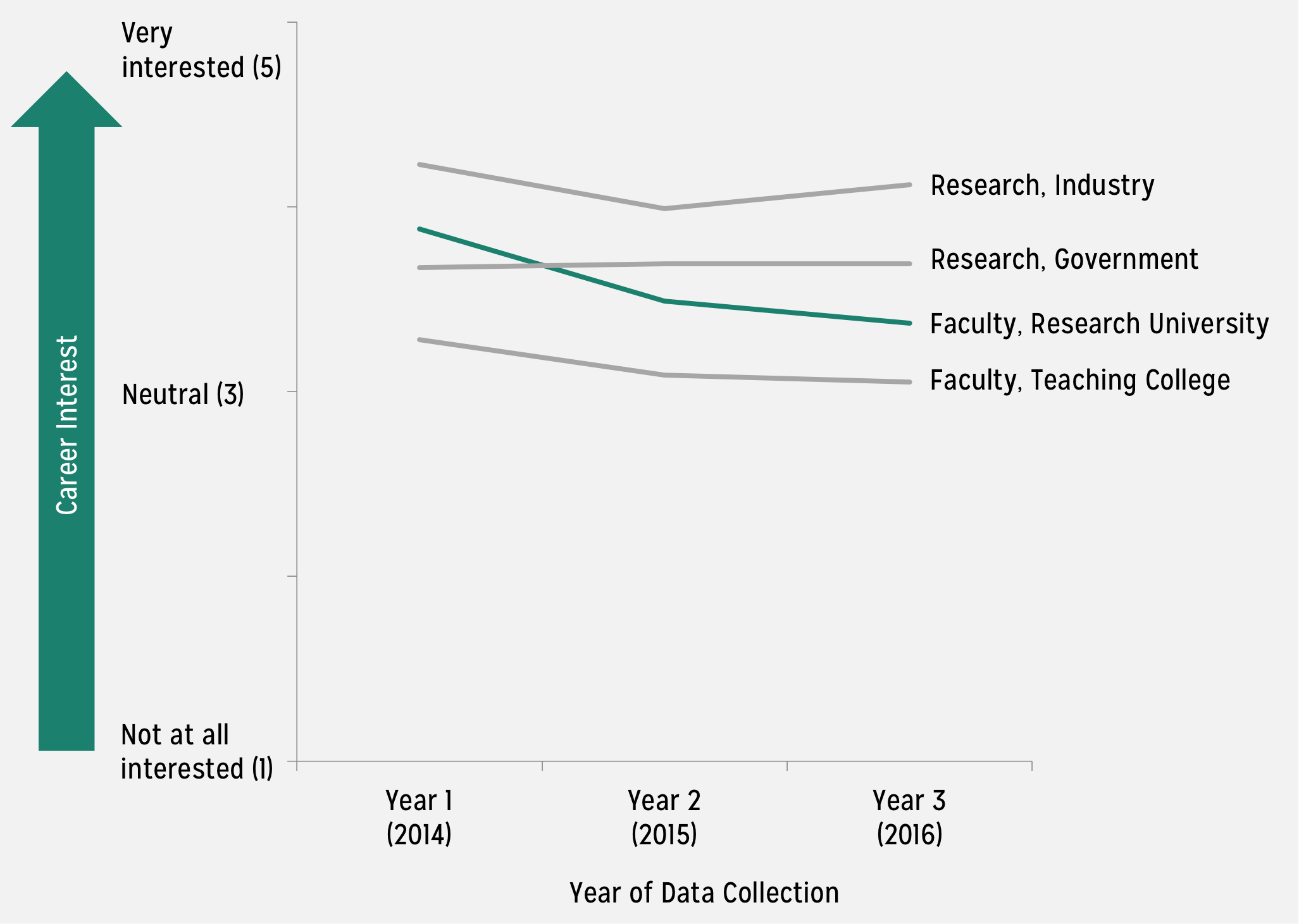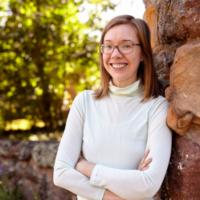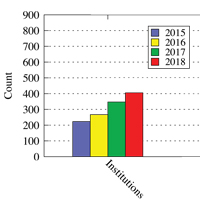Are Ph.D. Students Losing Interest in Faculty Positions at Research Universities?
 This graph shows doctoral students’ interest in different types of academic or other research focused careers in computing based on longitudinal data from a sample of U.S. Ph.D. students (n = 177) over a 3-year period. As they advance in their program, Ph.D. students’ interest in an academic career at a research university indicates a decline at a statistically significant rate, p < .05. Interest in academic teaching positions shows a similar decline in interest over time, but the magnitude of this decline is not statistically significant. Students’ interest in research-related industry positions drops after a year, but increases a year after that. Finally, interest in research-related positions in government does not change over time. Note that while these trends are intriguing, more data are needed to ensure the findings are reliable. To this end, CERP is currently collecting a fourth wave of data.
This graph shows doctoral students’ interest in different types of academic or other research focused careers in computing based on longitudinal data from a sample of U.S. Ph.D. students (n = 177) over a 3-year period. As they advance in their program, Ph.D. students’ interest in an academic career at a research university indicates a decline at a statistically significant rate, p < .05. Interest in academic teaching positions shows a similar decline in interest over time, but the magnitude of this decline is not statistically significant. Students’ interest in research-related industry positions drops after a year, but increases a year after that. Finally, interest in research-related positions in government does not change over time. Note that while these trends are intriguing, more data are needed to ensure the findings are reliable. To this end, CERP is currently collecting a fourth wave of data.
A decline in interest in faculty positions at research universities is important given the state of academic faculty positions in computer science at U.S. universities. According to the Taulbee Survey, the actual and anticipated faculty size in computer science departments is increasing. The latest report from the Taulbee Survey [1] presents an expected 13% 2-year growth in computer science faculty size across all U.S. institutions that responded to the survey. On the other hand, a report by Craig Wills [2], which uses Taulbee data, indicates 49% of all faculty searches at Ph.D.-granting institutions for 2017 were unsatisfactory; either they failed completely (12%) or resulted in hiring of fewer candidates than intended (37%). That is, almost half of Ph.D.-granting institutions with open searches were unable to fill all of the positions they advertised. Graduate students’ interest in academic careers may relate to the availability of quality candidates to meet the increasing demand for computer science faculty. Thus, it is important to explore factors that may be causing the decline in students’ interest in academic careers.
- Zweben, S., & Bizot, B. (2017). 2016 Taulbee Survey. Computing Research News, 2 (5). Retrieved December 8, 2017, from https://s8968.pcdn.co/crn/wp-content/uploads/sites/7/2017/05/2016-Taulbee-Survey.pdf
- Wills, C. E. (2017). Outcomes of Advertised Computer Science Faculty Searches for 2017(Rep.). Retrieved December 8, 2017, from http://web.cs.wpi.edu/~cew/papers/outcomes17.pdf
Notes:
CERP collected longitudinal survey data from Ph.D. students enrolled at a sample of U.S. universities via the Data Buddies Project. Data were collected from a sample of students during 2014, 2015, and 2016. The students in this graph are those who were enrolled as a Ph.D. student and responded to the career interest questions during all three waves of data collection (n = 177). The academic year status of the students in the resulting sample in the first year of data collection (2014) were as follows: 29% first year, 25% second year, 28% third year, 9% fourth year, and 9% fifth year or above. Students were asked How interested are you in the following types of careers?: tenured faculty in a computing department at a research university; tenured faculty in a computing department at a teaching college; computing researcher in industry; and computing researcher in a government lab, using the following scale: 1 (very uninterested) to 5 (very interested). A linear effect of time was tested using a repeated measures analysis of variance on each career type. The only career type that showed a statistically significant linear change over time was interest in an academic career at a research university (p < .001); this linear effect showed a decrease in interest over time.
 This analysis is brought to you by the CRA’s Center for Evaluating the Research Pipeline (CERP). CERP provides social science research and comparative evaluation for the computing community. To subscribe to the CERP newsletter, click here.
This analysis is brought to you by the CRA’s Center for Evaluating the Research Pipeline (CERP). CERP provides social science research and comparative evaluation for the computing community. To subscribe to the CERP newsletter, click here.
This material is based upon work supported by the National Science Foundation under Grant Number (CNS-1246649; and/ or DUE-1431112). Any opinions, findings, and conclusions or recommendations expressed in this material are those of the author(s) and do not necessarily reflect the views of the National Science Foundation.









